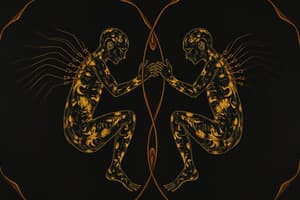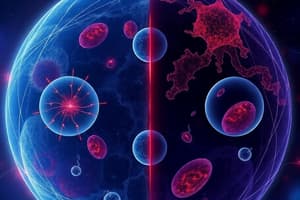Podcast
Questions and Answers
What is the difference between haploid and diploid states?
What is the difference between haploid and diploid states?
- Haploid state has one extra chromosome compared to diploid state
- Haploid state has half the number of chromosomes as diploid state (correct)
- Haploid state has double the number of chromosomes as diploid state
- Haploid state has the same number of chromosomes as diploid state
What is the role of centromere in cell division?
What is the role of centromere in cell division?
- Centromere is not involved in cell division
- Centromere regulates the start of cell division
- Centromere joins sister chromatids together (correct)
- Centromere separates sister chromatids
What is the concept of reduction division in meiosis?
What is the concept of reduction division in meiosis?
- Reduction division refers to the division that occurs after mitosis
- Reduction division refers to the division that doubles the chromosome number
- Reduction division refers to the division that reduces the chromosome number by half (correct)
- Reduction division refers to the division that only occurs in prokaryotes
What is the total number of chromatids in humans after replication of homologous chromosomes?
What is the total number of chromatids in humans after replication of homologous chromosomes?
What is the scientific name for yeast?
What is the scientific name for yeast?
What is the chromosome number of garden pea (Pisum sativum)?
What is the chromosome number of garden pea (Pisum sativum)?
Which organism has a chromosome number of 94?
Which organism has a chromosome number of 94?
What is the role of homologous chromosomes in cell division?
What is the role of homologous chromosomes in cell division?
What is the chromosome number of humans in diploid state?
What is the chromosome number of humans in diploid state?
What is the difference between mitosis and meiosis?
What is the difference between mitosis and meiosis?
Which phase of the eukaryotic cell cycle is responsible for DNA replication?
Which phase of the eukaryotic cell cycle is responsible for DNA replication?
What is the main difference between mitosis and meiosis?
What is the main difference between mitosis and meiosis?
What is the purpose of cytokinesis in cell division?
What is the purpose of cytokinesis in cell division?
What occurs during Prophase I of meiosis?
What occurs during Prophase I of meiosis?
In which type of cell division does synapsis and crossing over occur?
In which type of cell division does synapsis and crossing over occur?
What is the result of meiosis II?
What is the result of meiosis II?
Which statement about eukaryotic cells undergoing mitosis and meiosis is true?
Which statement about eukaryotic cells undergoing mitosis and meiosis is true?
What is the difference between diploid and haploid organisms?
What is the difference between diploid and haploid organisms?
What is the purpose of meiosis I in cell division?
What is the purpose of meiosis I in cell division?
Which term describes the process of eukaryotic cells dividing their DNA into daughter cells?
Which term describes the process of eukaryotic cells dividing their DNA into daughter cells?
Which phase of the eukaryotic cell cycle is responsible for DNA replication?
Which phase of the eukaryotic cell cycle is responsible for DNA replication?
What occurs during Prophase I of meiosis?
What occurs during Prophase I of meiosis?
What is the result of meiosis II?
What is the result of meiosis II?
What is the purpose of cytokinesis in cell division?
What is the purpose of cytokinesis in cell division?
What is the main difference between mitosis and meiosis?
What is the main difference between mitosis and meiosis?
What is the chromosome number of humans in diploid state?
What is the chromosome number of humans in diploid state?
What is the concept of reduction division in meiosis?
What is the concept of reduction division in meiosis?
What is the difference between haploid and diploid states?
What is the difference between haploid and diploid states?
What is the role of homologous chromosomes in cell division?
What is the role of homologous chromosomes in cell division?
Which statement about eukaryotic cells undergoing mitosis and meiosis is true?
Which statement about eukaryotic cells undergoing mitosis and meiosis is true?
During which phase of the eukaryotic cell cycle does cytokinesis occur?
During which phase of the eukaryotic cell cycle does cytokinesis occur?
What is the main difference between mitosis and meiosis?
What is the main difference between mitosis and meiosis?
What is the significance of synapsis in meiosis?
What is the significance of synapsis in meiosis?
In which type of cell is meiosis most likely to occur?
In which type of cell is meiosis most likely to occur?
What is the result of meiosis I?
What is the result of meiosis I?
Which phase of meiosis involves the alignment of homologous chromosomes at the cell's equator?
Which phase of meiosis involves the alignment of homologous chromosomes at the cell's equator?
What is the role of meiosis in sexual reproduction?
What is the role of meiosis in sexual reproduction?
What is the term for the process by which eukaryotic cells divide their DNA into daughter cells?
What is the term for the process by which eukaryotic cells divide their DNA into daughter cells?
What is the key difference between diploid and haploid organisms?
What is the key difference between diploid and haploid organisms?
What is the significance of meiosis in the context of genetic diversity?
What is the significance of meiosis in the context of genetic diversity?
Flashcards
Haploid state
Haploid state
A cell containing only one set of chromosomes.
Diploid state
Diploid state
A cell containing two sets of chromosomes.
Centromere
Centromere
Region of a chromosome where the two sister chromatids are joined.
Reduction division
Reduction division
Signup and view all the flashcards
Sister chromatids
Sister chromatids
Signup and view all the flashcards
Human chromatids after replication
Human chromatids after replication
Signup and view all the flashcards
Saccharomyces cerevisiae
Saccharomyces cerevisiae
Signup and view all the flashcards
Garden pea chromosome number
Garden pea chromosome number
Signup and view all the flashcards
Goldfish chromosome number
Goldfish chromosome number
Signup and view all the flashcards
Homologous chromosomes
Homologous chromosomes
Signup and view all the flashcards
Human diploid chromosome number
Human diploid chromosome number
Signup and view all the flashcards
Mitosis
Mitosis
Signup and view all the flashcards
Meiosis
Meiosis
Signup and view all the flashcards
S phase
S phase
Signup and view all the flashcards
Cytokinesis
Cytokinesis
Signup and view all the flashcards
Prophase I (Meiosis)
Prophase I (Meiosis)
Signup and view all the flashcards
Meiosis II
Meiosis II
Signup and view all the flashcards
Meiosis I
Meiosis I
Signup and view all the flashcards
Diploid vs. Haploid Organisms
Diploid vs. Haploid Organisms
Signup and view all the flashcards
Synapsis
Synapsis
Signup and view all the flashcards
Crossing over
Crossing over
Signup and view all the flashcards
Metaphase I
Metaphase I
Signup and view all the flashcards
Gametes
Gametes
Signup and view all the flashcards
Mitosis vs Meiosis: Result
Mitosis vs Meiosis: Result
Signup and view all the flashcards
Genetic Diversity
Genetic Diversity
Signup and view all the flashcards
Cytokinesis Phase
Cytokinesis Phase
Signup and view all the flashcards
Meiosis in Sexual Reproduction
Meiosis in Sexual Reproduction
Signup and view all the flashcards
Study Notes
Cell Division: Mitosis and Meiosis Overview
- Mitosis is a cell division mechanism primarily occurring in non-reproductive cells, while meiosis occurs in cells participating in sexual reproduction, specifically germ line cells.
- The eukaryotic cell cycle consists of distinct phases: Interphase (G1, S, G2 phases), Prophase, Metaphase, Anaphase, Telophase, and Cytokinesis.
- During mitosis, a division of the nuclear contents occurs, with four distinct stages: Prophase, Metaphase, Anaphase, and Telophase.
- Cytokinesis occurs at the end of mitosis, resulting in the formation of daughter cells by either actin filaments contracting in animals or the formation of a new cell wall in plants.
- Meiosis is a reduction division resulting in the formation of gametes, achieved through two key events: meiosis I, which separates homologous chromosomes, and meiosis II, which separates replicated sister chromatids.
- Meiosis I consists of Prophase I, Metaphase I, Anaphase I, and Telophase I, while Meiosis II includes Prophase II, Metaphase II, Anaphase II, and Telophase II.
- Meiosis involves synapsis, where homologous chromosomes pair up and crossing over occurs, leading to the final amount of genetic material passed to the gametes being halved.
- Eukaryotic cells undergo mitosis for growth and repair, while meiosis is essential for sexual reproduction, resulting in the formation of haploid gametes.
- Diploid organisms have homologous pairs of chromosomes in somatic cells, while haploid organisms have only one set of chromosomes.
- Mitosis and meiosis are the two mechanisms by which eukaryotic cells divide their DNA into daughter cells.
Studying That Suits You
Use AI to generate personalized quizzes and flashcards to suit your learning preferences.




